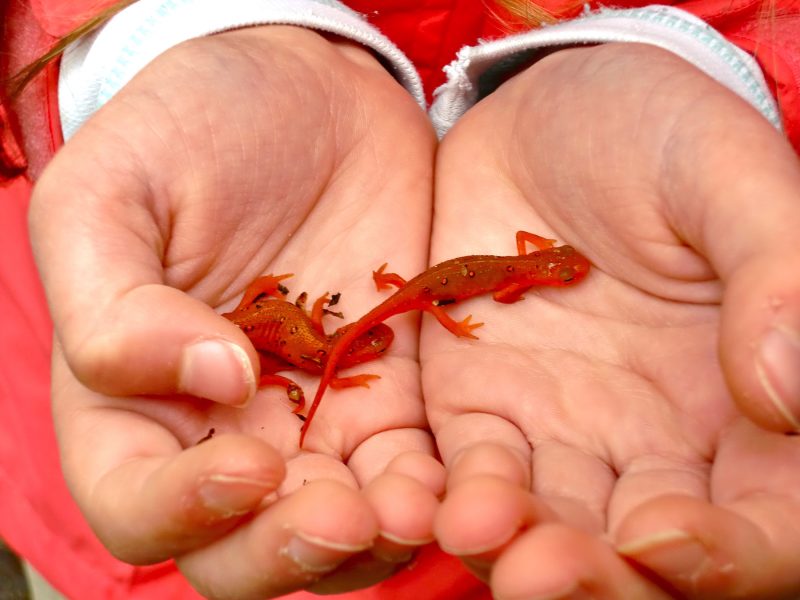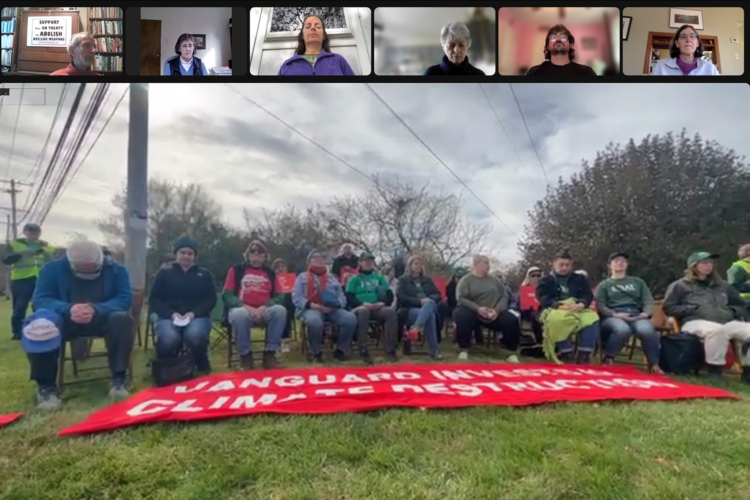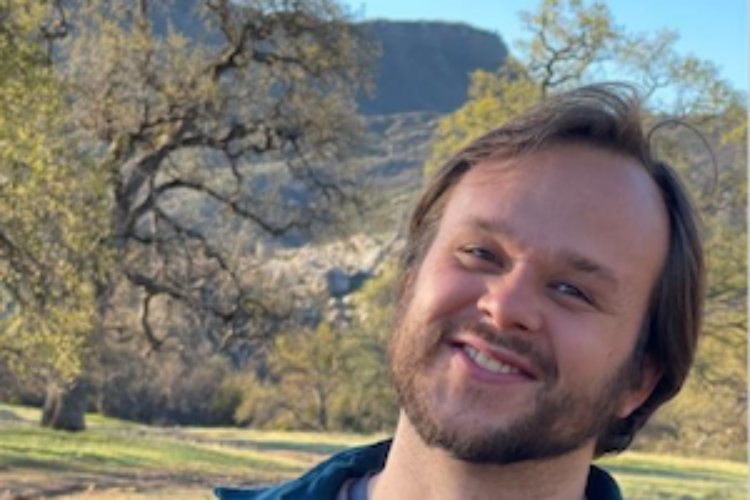Let Nature Teach

By Dan Kriesberg.
AN EXCELLENT MEASURE of how much children are learning is to count the number of times the teacher says “Pay attention.” The fewer “pay attentions” the more learning. In my own experience of 30 years as a science teacher, a 4th-grade teacher, and even as a swim instructor, I said the fewest “pay attentions” while I worked at an outdoor education center. At the center, nature did the teaching and I was the assistant. Trees, animals, flowers, rocks, and water were all teachers. No words or lessons or websites or videos could have taught as effectively.
On every hike I led I hoped for the moment when someone would scream, “What is that?” My favorite moment was when someone had found a red eft. The bright red, lizard-like body, covered in spots, was hard to miss. More shrieking would ensue, followed by:
“Eeyou!”
“Gross!”
“Is it a lizard?”
“Is it poisonous?”
Eventually, one brave soul would ask, “Can we touch it?”
I would carefully pick up the eft, cup it in my hands, and wait for the hush of anticipation. I’d explain how this amphibian was the land stage in the life cycle of a red-spotted newt. This little guy had begun life in a nearby pond growing from an aquatic stage into a red eft, who then crawled into the forest for a year or two before heading back to the pond where it would finish its metamorphosis into a newt. The story led to many questions.
“What do they eat?”
“How do they know where to go?”
“What do they do in the winter?”
Not once would I have to say “pay attention.”
I’d gently put the eft in the hands of anyone who wanted, but only for a few seconds. That was all it took, a few seconds. It was at that moment children came to some understanding that they do hold lives in their hands.
Holding the red eft taught them knowledge I could never explain with words. After every child had the chance to hold the creatures in their hands, I would place the efts softly on the ground and respond to a chorus of more questions. From then on the children were more attentive, more aware, and more in tune. With senses wide open, they discovered other wonders as well. It might have been a frog or a fungus. Perhaps a rock with a fossil that spoke of ancient times or feathers from a bird killed by a fox.
A key to a more sustainable world comes from red efts and the other hold-in-your-hands creatures. They teach wonder with their faint touches of toes, and the “S”-swerves across the palm of a child’s hand. There are countless wonders in the wild, but it takes direct contact with wild nature to learn stewardship, and we need stewards of the land. The children always hold red efts with the care of a surgeon’s hand. They learn to care and be attentive.
The word attention comes from the word attendere which means “to stretch toward.” Attention is an action; it is not a passive activity. Paying attention is a skill that requires practice and patience. The reward is wonder. Having a developed sense of wonder means using all senses. It means having and enjoying questions. There is pleasure in the mystery that comes without knowing. There is the wonder for the surprise of figuring things out and happening upon an answer. There is joy in learning for oneself. This wonder allows for more “wow” and more questions, both of which lead to true understanding of a place. This skill comes from learning in wild nature.
For many, attentiveness to wild nature is a lost and forgotten skill, but it is still essential. Being a keen observer of the natural world was critical to our survival in the past and I argue that is still essential to our survival in the present. We need children (and adults) to pay attention to the natural world, to notice when new plants are growing, and other plants are dying. To realize some birds are arriving earlier in the spring and others no longer sing. Without paying attention to our home ground, the subtle changes that indicate what is happening will go unseen. Environmental problems go unnoticed, and when care is finally paid, it may be too late.
Research by Nancy M. Wells and Kristi S. Lekies at Cornell University found that “participation with ‘wild’ nature before age 11 is a particularly potent pathway toward shaping both environmental attitudes and behaviors in adulthood. When children become truly engaged with the natural world at a young age, the experience is likely to stay with them in a powerful way, shaping their subsequent environmental path. Unstructured play is even more influential than environmental education programs with more formal lessons.
Adults can help give the gift of nature by allowing children the opportunity to play and explore in the wild outdoors. In traditional cultures, children had elders who worked with the outdoors to guide them. Children need to know how to hold a frog just as much as how to hold a smartphone. This gift will also bring joy and prevent the fear that comes when the only talk of nature is the problems of pollution, extinction, climate change, and more. Fear does not lead to effective action. Love does.
Now that I am back teaching in a classroom the challenge is to apply what I have learned in a more structured setting. I need to be more creative to get my students outdoors. I look at every lesson and ask myself, Is there a way to teach this outside? Can I structure this in a way where the children learn by their own exploration? My school is fortunate to be located near several small nature preserves. The best lessons of the year are field trips. Over the years I have moved further away from planning the trips. We simply go. It may be only about an hour, but some time is better than no time. For the whole trip, we explore.
As Lowell Monke wrote in his essay, Unplugged Schools, “one of schooling’s most important tasks: to compensate for, rather than intensify, society’s excesses.” We need to make up for what society is not doing. Teachers must let go of their need to be in total control of the learning process. It is better to allow the natural habitat of the child to be the teacher and guide. Taking on a role as an elder who guides by showing instead of telling. Trust in the teachings of the wild and be the best educators by taking a step back so the children can take a step forward.


